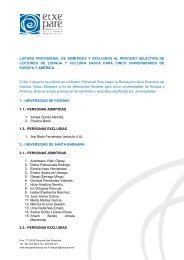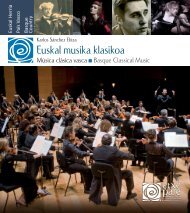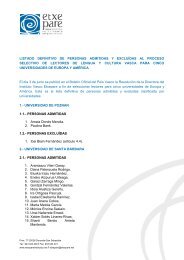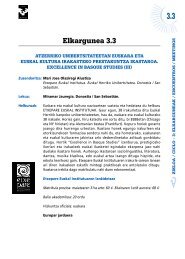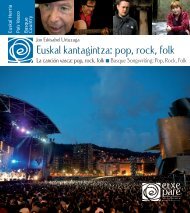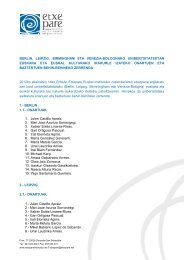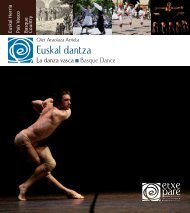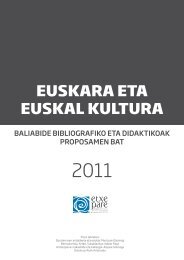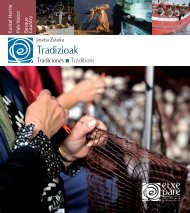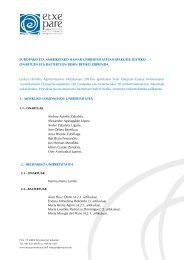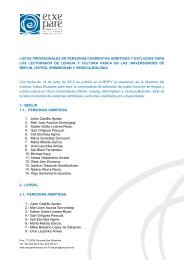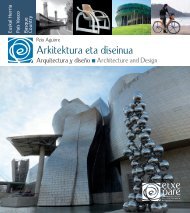XX. mendeko euskal literatura - Etxepare, Euskal Institutua
XX. mendeko euskal literatura - Etxepare, Euskal Institutua
XX. mendeko euskal literatura - Etxepare, Euskal Institutua
You also want an ePaper? Increase the reach of your titles
YUMPU automatically turns print PDFs into web optimized ePapers that Google loves.
can una reflexión metanarrativa (Juan Garzia, Anjel<br />
Lertxundi, Iban Zaldua, Aurelia Arkotxa...); narraciones<br />
donde la fantasía se tiñe a veces de situaciones<br />
absurdas (Karlos Linazasoro, Harkaitz Cano...); microrrelatos<br />
(Iban Zaldua, Joseba Sarrionandia, Karlos<br />
Linazasoro).<br />
Uno de los autores más destacados en el ámbito de la<br />
narración es Joseba Sarrionandia (1958). Narrazioak<br />
(1983), Atabala eta euria (1986) e Ifar Aldeko orduak<br />
(1991) son algunos de sus libros. Su prosa está llena<br />
de metáforas e imágenes sugerentes; en sus obras, el<br />
autor combina elementos fantásticos con referencias<br />
a leyendas y cuentos tradicionales. En sus últimos<br />
libros de narraciones se pueden encontrar cuentos<br />
hiperbreves, de gran intensidad.<br />
La narrativa de Inazio Mujika Iraola (1963) es próxima<br />
al realismo mágico y a autores como Juan Rulfo.<br />
Los cuentos de su primera colección, Azukrea<br />
belazeetan (1987), se sitúan en la localidad ficticia<br />
Auzunea. Dicha geografía bebe de la tradición vasca,<br />
y en la misma se transgreden leyes morales las<br />
cuales se pagan, al igual que sucede en los trabajos<br />
de Rulfo, Faulkner y Atxaga, con la metamorfosis. En<br />
sus siguientes narraciones Mujika Iraola opta por la<br />
leyenda y la erudición borgiana.<br />
La angustia existencial es el eje central de muchas de<br />
las narraciones de Karlos Linazasoro (1962). Entre su<br />
abundante producción son de destacar las colecciones<br />
Eldarnioak (1991), Zer gerta ere (1994), Ez balego<br />
beste mundurik (2000) e Ipuin errotikoak (2001).<br />
Los cuentos de Linazasoro presentan historias absurdas<br />
y asfixiantes que aciertan a reflejar las contradicciones<br />
de la realidad que nos rodea. En opinión del<br />
autor, el cuento es el género que mayor libertad le da<br />
a la hora de romper con todo tipo de leyes.<br />
En su primer libro de narraciones, Emakume biboteduna<br />
(1992), el escritor y músico Xabier Montoia<br />
(1955) hizo suyas las técnicas del realismo sucio a<br />
la hora de componer una serie de narraciones sobre<br />
el amor y el desamor. Los cuentos presentes en<br />
of the fantasy variety (Hasier Etxeberria, Unai Elorriaga,<br />
Imanol Zurutuza) or that resembling the<br />
American dirty realism of Carver or Wolff (Pako<br />
Aristi, Xabier Mendiguren, Edorta Jiménez, Xabier<br />
Montoia, Arantxa Iturbe, Pello Lizarralde); culturalist<br />
kinds of short stories that seek metanarrative<br />
reflection (Juan Garzia, Anjel Lertxundi, Iban Zaldua,<br />
Aurelia Arkotxa); narrations where fantasy occasionally<br />
takes on the guise of absurd situations (Karlos<br />
Linazasoro, Harkaitz Cano); and microfiction (or the<br />
short short story) (Iban Zaldua, Joseba Sarrionandia,<br />
Linazasoro).<br />
One of the most prominent authors in the short story<br />
field is Joseba Sarrionandia (1958). His books in this<br />
field include Narrazioak (1983), Atabala eta euria<br />
(1986) and Ifar Aldeko orduak (1991). His prose is full<br />
of metaphors and suggestive images; in his work, the<br />
author combines fantasy elements with legends and<br />
traditional tales. In his latest short story works one<br />
can find highly intense extremely short tales.<br />
The narrative of Inazio Mujika Iraola (1963) resembles<br />
magic realism and authors like Juan Rulfo. The<br />
short stories in his first collection, Azukrea belazeetan<br />
(1987), take place in the fictional place Auzune,<br />
a landscape which draws inspiration from Basque<br />
traditions. Here, moral laws are transgressed and<br />
this transgression is paid for, in the same way as in<br />
the work of Rulfo, Faulkner and Atxaga, by metamorphosis.<br />
In his later work Mujika Iraola tends more<br />
towards legend and Borgesian erudition.<br />
Existential suffering is the central focus of many<br />
short stories by Karlos Linazasoro (1962). Amongst<br />
his abundant work, the collections Eldarnioak<br />
(1991), Zer gerta ere (1994), Ez balego beste mundurik<br />
(2000) and Ipuin errotikoak (2001) stand out.<br />
Linazasoro’s short stories are full of asphyxiating absurd<br />
tales which manage to reflect the contradictions<br />
in the reality that surrounds us. For this author, the<br />
short story is the genre which gives him most freedom<br />
when attempting to break all kinds of rules.<br />
47



